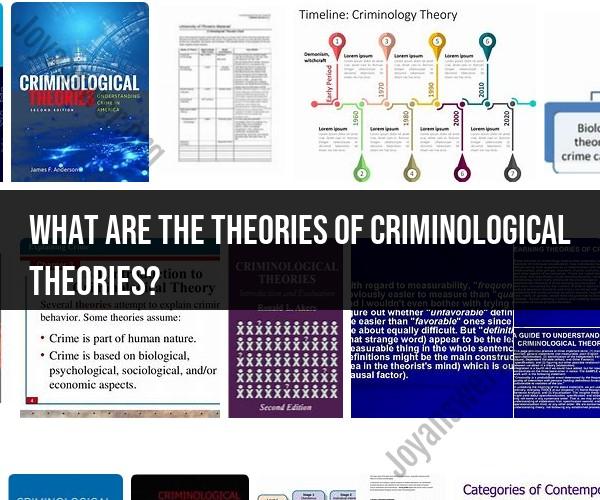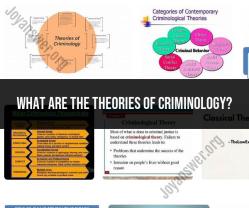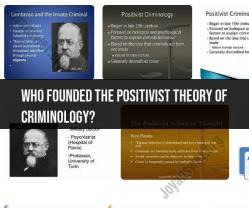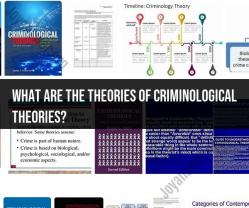What are the theories of criminological theories?
Criminological theories are frameworks or models that seek to explain why individuals engage in criminal behavior. These theories help criminologists, law enforcement, policymakers, and researchers better understand the causes and motivations behind criminal acts. There are several major categories of criminological theories, each with its own perspective on the causes of crime. Here are some of the most well-known criminological theories:
Classical Criminology:
- Key Figures: Cesare Beccaria, Jeremy Bentham
- Main Ideas: Classical criminology emphasizes the rationality of individuals and their free will to make choices. It argues that individuals commit crimes when they perceive the benefits of criminal behavior to outweigh the risks or punishments.
Positivist Criminology:
- Key Figures: Cesare Lombroso, Raffaele Garofalo
- Main Ideas: Positivist criminology focuses on the idea that some individuals may have biological, psychological, or sociological traits or factors that predispose them to criminal behavior. It seeks to identify these factors to prevent and rehabilitate offenders.
Strain Theory:
- Key Figures: Robert K. Merton, Albert Cohen
- Main Ideas: Strain theory suggests that individuals may turn to crime when they experience a disconnect between societal goals and the means available to achieve those goals. This strain can lead to frustration and criminal behavior.
Social Learning Theory:
- Key Figures: Edwin Sutherland, Ronald Akers
- Main Ideas: Social learning theory posits that individuals learn criminal behavior through interactions with others and exposure to criminal norms and values. It emphasizes the role of associations and socialization in shaping criminal conduct.
Control Theory:
- Key Figures: Travis Hirschi
- Main Ideas: Control theory argues that individuals are naturally inclined to commit crimes but are deterred by various social bonds and controls, such as attachment to others, commitment to conventional activities, involvement in society, and belief in moral values.
Labeling Theory:
- Key Figures: Howard Becker, Edwin Lemert
- Main Ideas: Labeling theory suggests that individuals may become deviant or engage in criminal behavior as a result of being labeled as deviant by society. The label can create a self-fulfilling prophecy, leading to further deviance.
Routine Activities Theory:
- Key Figures: Lawrence E. Cohen, Marcus Felson
- Main Ideas: Routine activities theory posits that crime occurs when three elements converge: a motivated offender, a suitable target, and a lack of capable guardianship. Crime prevention efforts focus on disrupting this convergence.
Conflict Theory:
- Key Figures: Karl Marx, George Vold
- Main Ideas: Conflict theory argues that crime and criminal justice are influenced by societal inequalities and power struggles. It suggests that the criminal justice system may serve the interests of the powerful while disadvantaging marginalized groups.
Life-Course Theory:
- Key Figures: Terrie E. Moffitt, Robert J. Sampson
- Main Ideas: Life-course theory examines how criminal behavior evolves over an individual's life. It considers factors such as childhood experiences, transitions, and turning points that can lead to desistance or persistence in criminal behavior.
Biosocial Theories:
- Main Ideas: Biosocial theories explore the interaction between biological and social factors in shaping criminal behavior. These theories examine genetic, neurological, and environmental influences on crime.
It's important to note that these theories are not mutually exclusive, and different theories may apply to different individuals and situations. Criminologists and researchers continue to refine and expand these theories to gain a deeper understanding of criminal behavior and inform crime prevention and criminal justice policies.
Criminology is the study of crime and criminal behavior. Criminologists seek to understand why people commit crimes, what factors contribute to crime, and how crime can be prevented and controlled.
There are many different criminological theories, each of which offers a different explanation for crime causation. Some of the most common criminological theories include:
- Classical theory: Classical theory views crime as a rational choice that individuals make based on the perceived costs and benefits of committing a crime.
- Biological theory: Biological theory suggests that there is a genetic component to crime, and that certain people are more likely to commit crimes due to their biology.
- Psychological theory: Psychological theory suggests that crime is caused by individual psychological factors, such as personality disorders, mental illness, and cognitive impairment.
- Sociological theory: Sociological theory suggests that crime is caused by social factors, such as poverty, inequality, and social disorganization.
Contemporary criminological theories often draw on multiple theoretical perspectives to explain crime causation. For example, some theories combine classical and biological theories to suggest that individuals are more likely to commit crimes if they have a genetic predisposition to crime and they also perceive the benefits of crime to outweigh the costs.
Here are some examples of contemporary criminological theories:
- Social control theory: Social control theory suggests that crime is caused by a lack of social bonds. Individuals with strong social bonds are less likely to commit crimes because they have something to lose (e.g., relationships, jobs, etc.) if they are caught.
- Rational choice theory: Rational choice theory suggests that individuals make a rational decision to commit a crime based on the perceived costs and benefits of the crime. Individuals are more likely to commit crimes if they believe that the benefits of the crime outweigh the costs (e.g., if they think they will not get caught or if they think the punishment will be light).
- Routine activities theory: Routine activities theory suggests that crime occurs when three elements are present: a motivated offender, a suitable target, and a lack of guardianship. Criminals are more likely to commit crimes if they have an opportunity to do so without being caught.
Criminological theories are important because they can help us to understand the root causes of crime and to develop effective crime prevention and control strategies. By understanding why people commit crimes, we can better target our efforts to prevent crime and to rehabilitate offenders.





